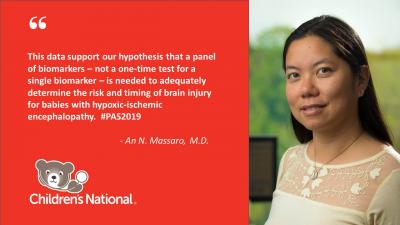Prescription opioid misuse results in numerous poor health consequences among children in the US; however, knowledge of recent opioid prescribing trends in Medicaid-enrolled children are conflicting and limited to certain subpopulations

Credit: Children’s National
BALTIMORE – A new study describes trends in filled opioid prescriptions by patient and clinical characteristics for Medicaid-enrolled children. Findings from the study will be presented during the Pediatric Academic Societies (PAS) 2019 Meeting, taking place on April 24 – May 1 in Baltimore.
“In this retrospective cohort study of Medicaid-enrolled children and young adults (1 to 21 years old) we found that filled opioid prescriptions are relatively rare (1% of all visits) and adjusted rates decreased from 2012 to 2016,” said Abbey Masonbrink, MD, MPH, a pediatric hospitalist at Children’s Mercy Kansas City and one of the authors of the study. “Providers frequently prescribed opioids combined with non-opioid analgesics and opioids with a black box or safety warning. Future efforts should support development of pediatric pain management guidelines based in a multimodal approach to minimize use of opioids and target reduction of opioids with pediatric safety warnings.”
This study involved a retrospective cohort study of children 1 to 21 years old enrolled in Medicaid from 2012-2016 using the IBM Watson Medicaid Marketscan claims database. It defined clinical visits as an “opioid visit” if there was a new opioid prescription filled in a retail pharmacy within seven days of the visit. The opioid visit was then assigned to the clinical provider most likely to have prescribed an opioid. Only visits to providers submitting claims in every year from 2012-2016 were included. Changes in patient and clinical characteristics over time were assessed using descriptive statistics and chi-square tests and logistic regression was used to estimate the change in adjusted probability of an opioid visit over time. Due to the large volume of visits analyzed, p
From 2012 to 2016, there were 113,068,027 visits among Medicaid-enrolled children and 1% (n=1,130,006) of these were considered an opioid visit. After adjusting for patient demographics, the researchers found that the adjusted probability for an opioid prescription decreased from 1.2% to 0.8% from 2012 to 2016. The clinical settings with the highest adjusted rates of opioid prescriptions were dental surgery (29%), surgery (21%), and inpatient (upon-discharge) (10%). Furthermore, the adjusted rates of an opioid visit significantly decreased (p
Opioid prescriptions filled in Medicaid-enrolled children are relatively rare (1% of all visits), however adjusted rates of opioid visits decreased from 2012 to 2016. Understanding changes in prescriptions over time can inform opioid stewardship efforts to develop clinical guidelines for appropriate pain management in children.
Dr. Masonbrink will present findings from “Changes in Opioid Prescriptions for Medicaid-enrolled Children, 2012-2016” on Sunday, April 28 at 8 a.m. EDT. Reporters interested in an interview with Dr. Masonbrink should contact [email protected]. Please note that only the abstracts are being presented at the meeting. In some cases, the researchers may have additional data to share with media.
The PAS 2019 Meeting brings together thousands of pediatricians and other health care providers to improve the health and well-being of children worldwide. For more information about the PAS 2019 Meeting, please visit http://www.
###
About the Pediatric Academic Societies Meeting
The Pediatric Academic Societies (PAS) Meeting brings together thousands of pediatricians and other health care providers united by a common mission: to improve the health and well-being of children worldwide. This international gathering includes pediatric researchers, leaders in pediatric academics, clinical care providers and community practitioners. Presentations cover issues of interest to generalists as well as topics critical to a wide array of specialty and sub-specialty areas. The PAS Meeting will be the premier North American scholarly child health meeting. The PAS Meeting is produced through a partnership of four pediatric organizations that are leaders in the advancement of pediatric research and child advocacy: American Pediatric Society, Society for Pediatric Research, Academic Pediatric Association and American Academy of Pediatrics. For more information, please visit http://www.
Abstract: Changes in Opioid Prescriptions for Medicaid-enrolled Children, 2012-2016
Background: Prescription opioid misuse results in numerous poor health consequences among children in the United States; however, literature describing opioid prescriptions in Medicaid-enrolled children is lacking or demonstrates conflicting findings. Understanding the epidemiology of opioid fill patterns is essential to address the current opioid crisis.
Objective: To describe trends in filled opioid prescriptions by patient and clinical characteristics for Medicaid-enrolled children.
Design/Methods: We performed a retrospective cohort study of children aged 0-21 years old enrolled in Medicaid from 2012-2016 using the IBM Watson Medicaid Marketscan claims database. We defined clinical visits as an “opioid visit” if there was a new opioid prescription filled in a retail pharmacy within 7 days of the visit. The opioid visit was then assigned to the clinical provider most likely to have prescribed an opioid. Only visits to providers submitting claims in every year from 2012-2016 were included. We assessed changes in patient and clinical characteristics over time using descriptive statistics and chi-square tests. We used logistic regression to estimate the change in adjusted probability of an opioid visit over time. Due to the large volume of visits analyzed, p
Results: From 2012 to 2016, there were 113,068,051 visits among Medicaid-enrolled children and 0.9% (n=1,049,851) of these were considered an opioid visit. Patient characteristics are described in Table 1. Clinical settings most likely to result in an opioid prescription were dental surgery (36%), followed by outpatient surgery (26%), and ED (4%). After adjusting for patient demographics, we found that the adjusted probability for an opioid prescription decreased from 2012-2016 (aOR 0.88 95% CI [0.88, 0.89], p
Conclusion(s): Opioid prescriptions filled in Medicaid-enrolled children are relatively rare (0.9% of all visits), however adjusted rates of opioid visits still decreased from 2012 to 2016. Understanding changes in prescriptions over time can help opioid stewardship programs develop clinical guidelines for appropriate pain management in children.
Authors (Last Name, First Name): Masonbrink, Abbey R.; Delzeit, Jennifer; Richardson, Troy; Catley, Delwyn; Miller, Melissa K.; Hall, Matt
Authors/Institutions: A.R. Masonbrink, D. Catley, Hospital Medicine, Children’s Mercy Hospital, Kansas City, Missouri, UNITED STATES|T. Richardson, Children’s Hospital Association, Lenexa, Kansas, UNITED STATES|M.K. Miller, Emergency Medicine, Children’s Mercy Hospital, Kansas City, Missouri, UNITED STATES|J. Delzeit, M. Hall, Informatics, Children’s Hospital Association, Lenexa, Kansas, UNITED STATES
Media Contact
PAS
[email protected]




